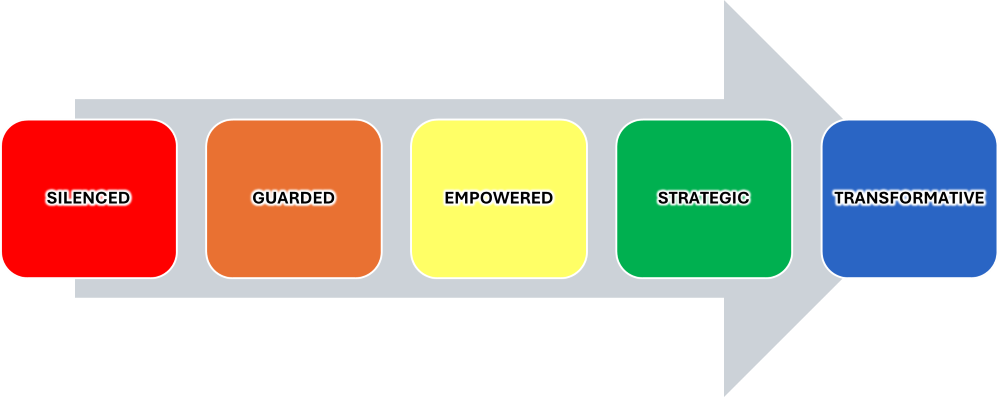
If all you hear is what's going right...
your communication culture might be wrong.
For decades, organizations have invested in basic communication training—speaking, writing, and listening—while overlooking skills related to communication safety. This includes the ability to:
- speak up against inappropriate or disrespectful behavior
- share concerns or mistakes without fear of negative consequences
- initiate and navigate difficult conversations respectfully
These skills can significantly impact organizational health, yet many organizations have room for improvement. Atana research shows that:
Following respectful workplace training,
87% of learners felt positive about speaking up against harassment but
43% expect negative consequences for doing so
Following workplace violence prevention training,
84% of learners agree they have the ability to share concerns about alarming conduct but
84% also feel there could be obstacles to sharing concerns
Following workplace violence prevention training,
84% of learners agree they have the ability to share concerns about alarming conduct but
84% also feel there could be obstacles to sharing concerns
The extent to which people speak up and share concerns, is a barometer for psychological safety within the organization or team. And psychological safety positively influences a number of critical organizational KPIs by contributing to:
- Reduced Risk: Problems surface and get addressed before escalating into costly crises
- Enhanced Innovation: Diverse perspectives enter the conversation, not just the loudest voices
- Improved Retention: Employees who feel heard stay longer and invest more in organizational success
- Greater Agility: Organizations adapt faster when information flows freely
Strong communication safety skills don't just complement traditional communication training—they help transform workplace culture and directly impact your bottom line.
Where Does Your Organization Fall on the Speak-Up Spectrum?






In Silenced organizations, concerns go unaddressed and inappropriate behaviors continue unchecked. Employees witness problems, or make mistakes, but stay quiet, fearing negative consequences for speaking up. Leadership may be unaware of brewing issues until they escalate into serious problems or result in unexpected departures.
Silenced Communication Warning Signs: Avoidance behaviors, unreported incidents, fear of retaliation, suppressed innovation
SILENCED
In Silenced organizations, concerns go unaddressed and inappropriate behaviors continue unchecked. Employees witness problems, or make mistakes, but stay quiet, fearing negative consequences for speaking up. Leadership may be unaware of brewing issues until they escalate into serious problems or result in unexpected departures.
Warning signs: Avoidance behaviors, unreported incidents, fear of retaliation, suppressed innovation


Guarded organizations have pockets of psychological safety, but speaking up remains risky and inconsistent. Employees carefully calculate when to speak and what to say. Leadership receives a partial, often overly positive picture of organizational reality.
Guarded Communiation Characteristics: Speaking up limited to safe topics, cautious participation in brainstorming or problem solving, managers unaware of problems on their own team
GUARDED
Guarded organizations have pockets of psychological safety, but speaking up remains risky and inconsistent. Employees carefully calculate when to speak and what to say. Leadership receives a partial, often overly positive picture of organizational reality.
Guarded Characteristics: Speaking up limited to safe topics, cautious participation in brainstorming or problem solving, managers unaware of problems on their own team


At the Empowered level, organizations begin intentionally cultivating a speak-up culture. Upstanders receive visible support when they address issues. Managers are receptive to feedback, and employees increasingly trust that their input matters. Still, skill and comfort in speaking up remain uneven.
Empowered Communication Foundations: Upstander behaviors emerging, employees contribute more, managers don’t take feedback personally, growing psychological safety
EMPOWERED
At the Empowered level, organizations begin intentionally cultivating a speak-up culture. Upstanders receive visible support when they address issues. Managers are receptive to feedback, and employees increasingly trust that their input matters. Sill, skill and comfort in speaking up remain uneven.
Empowered Communication Foundations: Upstander behaviors emerging, employees contribute more, managers don’t take feedback personally, growing psychological safety


Strategic organizations view open communication as a key advantage. Leaders proactively seek diverse perspectives and address difficult topics. Employees at all levels call out inappropriate behavior and provide input. There is high communication and high trust. Problems are identified early and resolved constructively.
Strategic Communication Hallmarks: Proactive issue identification at all levels, constructive dialogue during conflicts, workers motivated by their role in organizational success
STRATEGIC
Strategic organizations view effective communication as a key advantage. Leaders proactively seek diverse perspectives and address difficult topics. Employees across all levels call out inappropriate behavior and provide input. There is high communication and high trust. Problems are identified early and resolved constructively.
Strategic Communication Hallmarks: Proactive issue identification at all levels, constructive dialogue during conflicts, workers motivated by their role in organizational success


Speaking up is embedded in Transformative communication culture. All employees see addressing issues as core to their responsibilities. The organization excels at detecting problems early and innovating through collaboration. Difficult conversations are handled skillfully, strengthening relationships rather than damaging them.
Impact of Transformative Communication: Innovation through diverse perspectives, conflict as catalyst for growth, high engagement, positive culture and brand
TRANSFORMATIVE
Speaking up is embedded in Transformative communication culture. All employees see addressing issues as core to their responsibilities. The organization excels at detecting problems early and innovating through collaboration. Difficult conversations are handled skillfully, strengthening relationships rather than damaging them.
Impact of Transformative Communication: Innovation through diverse perspectives, conflict as catalyst for growth, high engagement, positive culture and brand
Assess Your Organization's Speak-Up Culture
Use the diagnostic True or False questions below to help determine your organization's position on the Speak-Up Spectrum. Consider each question thoughtfully – your answers will reveal valuable insights about your communication culture.
Employees are quick to speak up when they witness inappropriate behaviors.
True/False
True/False
Employees openly bring forward complaints and concerns, rather than using anonymous channels or waiting for an exit interview.
True/False
True/False
Employees readily admit they’ve made a mistake rather than try to cover it up.
True/False
True/False
Employees are quick to ask questions and offer ideas.
True/False
True/False
When employees speak up, they share concerns of a serious nature as well as minor issues.
True/False
True/False
All employees, regardless of department or role, are willing to speak up and share concerns.
True/False
True/False
All employees, regardless of department or role, are comfortable voicing a different perspective or an opposing opinion.
True/False
True/False
"Upstander" behaviors are recognized and rewarded.
True/False
True/False
Employees believe their managers will support them when they speak up.
True/False
True/False
There is evidence that input from all levels influences decisions.
True/False
True/False
There is evidence that input from all levels has improved innovation and problem solving in the organization.
True/False
True/False
Managers initiate difficult conversations with direct reports rather than avoiding them.
True/False
True/False
Teams are able to navigate disagreement while maintaining respect.
True/False
True/False
Employees see speaking up as a responsibility, not an option
True/False
True/False
Employees routinely bring forward both problems and possible solutions.
True/False
True/False
Interpreting Your Results
A "True" answer means a "safe to speak up" behavior is evident in your culture. A "False" (or "maybe") response suggests a potential barrier to safe communication. To get an idea of where your organization falls on the Speak-Up Spectrum, count your "true" responses.- 0-3 suggest a Silenced Communication culture. Think about each statement and possible reasons for a "False" response. Read "Tips for Increasing (or Maintaining) Communication Safety," below. Discuss with the leadership team.
- 4-6 suggest a Guarded Communication culture. Think about each statement and possible reasons for a "False" response. Read "Tips for Increasing (or Maintaining) Communication Safety," below. Discuss with the leadership team.
- 7-9 suggest an Empowered Communication culture. You're on your way! Think about possible reasons for a "False" response. Look at groupings and areas of safe communication. Consider reasons for barriers. Read "Tips for Increasing (or Maintaining) Communication Safety," below.
- 10-12 suggest a Strategic Communication culture. Way to go! While speaking up is not yet seen as a responsibility at all levels of the organization, your employees generally feel psychologically safe. Consider the "False" or "maybe statements and think about ways to improve in that area. Read "Tips for Increasing (or Maintaining) Communication Safety," below.
- 13-15 suggest a Transformative Communication culture is in place. This is the ideal. Your employees have high trust and feel safe speaking up. To help ensure you maintain the psychological safety your employees currently experience, read "Tips for Increasing (or Maintaining) Communication Safety," below.
Note: This diagnostic tool is intended to provide a snapshot of your oganization's communication safety. It is not a detailed assessment and is designed merely to get you thinking about areas where you could make it easier and safer for employees to speak up.
Tips for Increasing (or Maintaining) Communication Safety
No matter what level you're on, these best practices demonstrate that your organization prioritizes making it safe for people to speak up.
- Train managers on how to be inclusive. Do they regularly seek and value input from their team members?
- Encourage managers to question the communication status quo. When employees say everything is fine and there are never any issues or concerns, there may be problems brewing. Encourage employees to speak up even if it’s not positive.
- Coach managers on how to react to “bad news” or problems.
- Check your policies and training touchpoints (e.g. onboarding and compliance). Do they consistently communicate that the organization needs and expects its employees to speak up? Is your organizational messaging clear? Does it support and encourage upstanders?
- Determine whether managers regularly set expectations for speaking up and express that retaliation towards those who speak up or bring concerns forward will not be tolerated.
- Evaluate what supports are in place to equip and empower employees to speak up. For example, have they been trained on best practices for speaking up? Are how-to resources available for reporting things like harassment?
How to Know You’ve Made a Difference
Traditional communication skills training focuses primarily on completion rates rather than behavioral change. Through science-backed questions embedded in its courses, Atana's behavioral approach provides metrics on much more, including:
- Changes in behavioral intent to speak up
- Perceptions of leadership and co-worker support for speaking up
- Manager confidence in navigating difficult conversations
- Extent to which employees believe they are valued and that their input matters
Contact us to learn how Atana's behavior-based respectful workplace programs transform mandated training into strategic value, providing actionable insights into your organization's communication safety and clear pathways for improvement.







